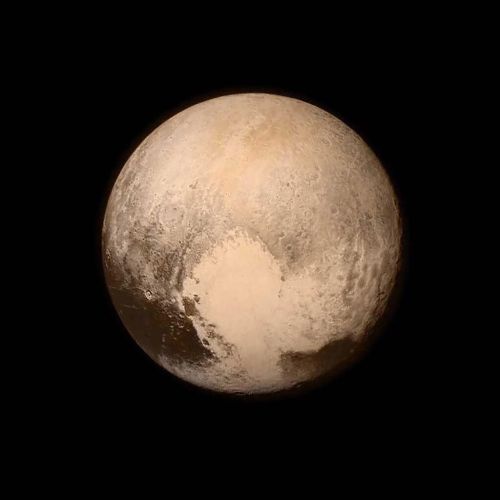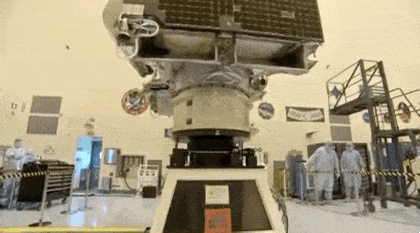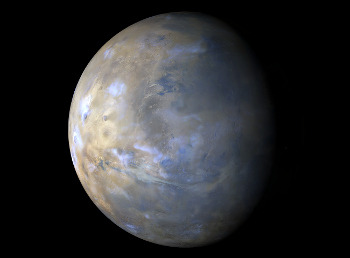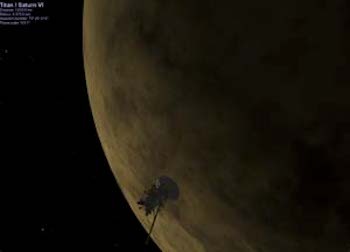Solar System 10 Things: Looking Back At Pluto
Solar System 10 Things: Looking Back at Pluto
In July 2015, we saw Pluto up close for the first time and—after three years of intense study—the surprises keep coming. “It’s clear,” says Jeffery Moore, New Horizons’ geology team lead, “Pluto is one of the most amazing and complex objects in our solar system.”
1. An Improving View

These are combined observations of Pluto over the course of several decades. The first frame is a digital zoom-in on Pluto as it appeared upon its discovery by Clyde Tombaugh in 1930. More frames show of Pluto as seen by the Hubble Space Telescope. The final sequence zooms in to a close-up frame of Pluto taken by our New Horizons spacecraft on July 14, 2015.
2. The Heart

Pluto’s surface sports a remarkable range of subtle colors are enhanced in this view to a rainbow of pale blues, yellows, oranges, and deep reds. Many landforms have their own distinct colors, telling a complex geological and climatological story that scientists have only just begun to decode. The image resolves details and colors on scales as small as 0.8 miles (1.3 kilometers). Zoom in on the full resolution image on a larger screen to fully appreciate the complexity of Pluto’s surface features.
3. The Smiles

July 14, 2015: New Horizons team members Cristina Dalle Ore, Alissa Earle and Rick Binzel react to seeing the spacecraft's last and sharpest image of Pluto before closest approach.
4. Majestic Mountains

Just 15 minutes after its closest approach to Pluto, the New Horizons spacecraft captured this near-sunset view of the rugged, icy mountains and flat ice plains extending to Pluto's horizon. The backlighting highlights more than a dozen layers of haze in Pluto's tenuous atmosphere. The image was taken from a distance of 11,000 miles (18,000 kilometers) to Pluto; the scene is 780 miles (1,250 kilometers) wide.
5. Icy Dunes

Found near the mountains that encircle Pluto’s Sputnik Planitia plain, newly discovered ridges appear to have formed out of particles of methane ice as small as grains of sand, arranged into dunes by wind from the nearby mountains.
6. Glacial Plains

The vast nitrogen ice plains of Pluto’s Sputnik Planitia – the western half of Pluto’s “heart”—continue to give up secrets. Scientists processed images of Sputnik Planitia to bring out intricate, never-before-seen patterns in the surface textures of these glacial plains.
7. Colorful and Violent Charon

High resolution images of Pluto’s largest moon, Charon, show a surprisingly complex and violent history. Scientists expected Charon to be a monotonous, crater-battered world; instead, they found a landscape covered with mountains, canyons, landslides, surface-color variations and more.
8. Ice Volcanoes

One of two potential cryovolcanoes spotted on the surface of Pluto by the New Horizons spacecraft. This feature, known as Wright Mons, was informally named by the New Horizons team in honor of the Wright brothers. At about 90 miles (150 kilometers) across and 2.5 miles (4 kilometers) high, this feature is enormous. If it is in fact an ice volcano, as suspected, it would be the largest such feature discovered in the outer solar system.
9. Blue Rays

Pluto's receding crescent as seen by New Horizons at a distance of 120,000 miles (200,000 kilometers). Scientists believe the spectacular blue haze is a photochemical smog resulting from the action of sunlight on methane and other molecules in Pluto's atmosphere. These hydrocarbons accumulate into small haze particles, which scatter blue sunlight—the same process that can make haze appear bluish on Earth.
10. Encore

On Jan. 1, 2019, New Horizons will fly past a small Kuiper Belt Object named MU69 (nicknamed Ultima Thule)—a billion miles (1.5 billion kilometers) beyond Pluto and more than four billion miles (6.5 billion kilometers) from Earth. It will be the most distant encounter of an object in history—so far—and the second time New Horizons has revealed never-before-seen landscapes.
Make sure to follow us on Tumblr for your regular dose of space: http://nasa.tumblr.com.
More Posts from Nasa and Others
Want to Send Your Art to the International Space Station?!
For children ages 4-12, we’re hosting an art contest! Get the details:





We are working with Boeing and SpaceX to build human spaceflight systems, like rockets and spacecraft, to take astronauts to the International Space Station. These companies will fly astronauts to orbit around Earth while we focus on plans to explore deeper into our solar system.

Get out your art supplies and use your creative imagination to show us the present and future of traveling in space!

There are no grocery stores in space, but there may soon be farms. Very small farms that are important to a crew conducting a mission to deep space. That’s because our astronauts will need to grow some of their own food. Researchers on Earth and astronauts on the International Space Station are already showing what is needed to grow robust plants in orbit.

What would you take to space? Astronaut Suni Williams took a cutout of her dog, Gorbie, on her first mission to the International Space Station.

Kids 4 to 12, draw what you would take and enter it in our Children’s Artwork Calendar contest! Your entry could be beamed to the space station!


Go to http://go.nasa.gov/2fvRLNf for more information about the competition’s themes, rules and deadlines plus the entry form.


Get your parent's permission, of course!
Email your entry form and drawing to us at: ksc-connect2ccp@mail.nasa.gov

Make sure to follow us on Tumblr for your regular dose of space: http://nasa.tumblr.com
Colors of Earth
When we think of our globe from a distance, we generally visualize two colors: blue and green. Water and land. Mostly water, consequently, our planet’s nickname of the blue marble.
Traveling around the globe every 90 minutes covering millions of miles with a focused lens on our beautiful planet from 250 miles above, I’ve captured many beautiful colors beyond blue and green that showcase Earth in new and interesting ways. Some colors are indicative of nature like desert sands and weather like snow. Other colors tell stories of Earth’s climate in bright splashes of yellows and greens of pollen and muted grey tones and clouded filters of pollution.
Blue and green still remain vivid and beautiful colors on Earth from the vantage point of the International Space Station, but here are some other colors that have caught my eye from my orbital perspective.

African violet

Bahamas blues

Tropical in Africa

Yellow desert

Orange in Egypt

Red surprise

Snow white
Follow my Year In Space on Twitter, Facebook and Instagram!

Question: would you rather be on the beach or would you rather gawk at it from space? For some, it’s a tough choice.
Astronaut Soichi Noguchi of the Japan Space Agency recently took this image of Andros Island, the largest island in the Bahamas. He and his three crew mates, NASA astronauts Victor Glover, Mike Hopkins and Shannon Walker, are currently living and working aboard the International Space Station for a six-month science mission. The crew launched on Nov. 15 from Kennedy Space Center and are conducting a number of scientific research, including Earth observation.
Every 90 minutes, the International Space Station completes one orbit around Earth. Because Earth rotates below them while they orbit, the crew get to see most of their beautiful blue marble of a planet from the unique vantage point of space. By photographing Earth from about 250 miles above the surface, astronauts can record phenomena such as storms in real time, and even provide input to ground teams. Make sure to follow us on Tumblr for your regular dose of space: http://nasa.tumblr.com.
What is a typical day in the international space station like?? I cant help but express my admiration for you.
We’re honored that New Horizon’s image of Pluto was recognized as one of 2015’s top 10 photos by @timemagazine.

TIME’s Top 10 Photos of 2015. ⠀⠀⠀⠀⠀⠀⠀⠀⠀ Each photograph, carefully culled from thousands and presented here unranked, reflects a unique and powerful point of view that represents the best of photojournalism this year. ⠀⠀⠀⠀⠀⠀⠀⠀⠀ 2015 gave us the ever picture of Pluto, made by @NASA’s New Horizons spacecraft. The high-resolution color image was taken more than nine years after the two cameras that shot it left Earth in the fastest spacecraft ever launched into space. “This is really the completion of a 50-year quest to explore all of the planets in our solar system,” says photographer Alan Stern (@alanstern). “NASA began under President Kennedy and finished under President Obama. I believe that 100 years from now, this image will be an icon from the year 2015.” ⠀⠀⠀⠀⠀⠀⠀⠀⠀ Read more from each #photographer at time.lightbox.com. ⠀⠀⠀⠀⠀⠀⠀⠀⠀ #topten #bestof2015 #pluto #space http://ift.tt/1O7fKGW
The Great Aviation Transformation Begins
On this National Aviation Day, we’re going “X.”
Today we celebrate the birthday of one of America’s original U.S. aviation pioneers — Orville Wright. But this year we also celebrate the pioneers of right now — the women and men of NASA who are changing the face of aviation by going “X.” We’re starting the design and build of a series of piloted experimental aircraft – X-planes – for the final proof that new advanced tech and revolutionary shapes will give us faster, quieter, cleaner ways to get from here to there.

So, what is an X-plane?
Since the early days of aviation, X-planes have been used to demonstrate new technologies in their native environment – flying through the air aboard an aircraft that’s shaped differently from the tube-and-wing of today. X-planes are the final step after ground tests. They provide valuable data that can lead to changes in regulation, design, operations, and options for travel. Two of the most famous historical X-planes are the Bell X-1 and the X-15.
Why can’t I fly supersonic now, say from New York to Seattle?

Because of the loud, jarring sonic boom. Commercial supersonic flight over land and, therefore over communities, is currently prohibited. Our supersonic X-plane will fly “quiet”; there’ll still be a sonic boom but it’ll sound more like a soft “thump.” The Low Boom Flight Demonstration X-plane, scheduled for first flight in 2021 and to begin community overflight testing in 2022, will provide the technical and human response data to federal and international regulators so they can consider lifting the ban. If that happens, someday commercial supersonic passenger flights between U.S. coasts would be less than three hours.

This is a preliminary design of the Low Boom Flight Demonstration X-plane. Its shape is carefully tailored to prevent the formation of a loud sonic boom.
Will I ever be able to carry on a conversation when a plane flies overhead?

Yes. Our next X-plane will be one that flies at regular speed, but has advanced design technologies and a nontraditional shape that drop perceived noise level by more than half. It will also reduce fuel consumption by 60-80 percent, and cut emissions by more than 80 percent. Design of this piloted X-plane is expected to begin around 2020.

This possible X-plane design is a blended wing body, which reduces drag and increases lift, and also reduces noise because the engines are placed above the fuselage.
Will I ever fly on an airplane powered like my Prius?

Probably. All- or hybrid-electric aircraft that can carry 12 – 120 passengers are becoming more likely. For a larger aircraft and possible future X-plane, NASA is studying how to use electric power generated by the engines to drive a large fan in a tail-cone and get additional thrust for takeoff and reduce fuel use.

This possible future subsonic X-plane would use electricity to power a large fan in the tail-cone, providing extra thrust at takeoff.
We – along with our government, industry and academic partners – have begun the great aviation transformation. And you’ll witness every important moment of our X-plane stories, here and on every #NationalAviationDay.

Like the X-plane posters for National Aviation Day? Download them: https://www.nasa.gov/aero/nasa-x/
Make sure to follow us on Tumblr for your regular dose of space: http://nasa.tumblr.com
From Seed to Market: How NASA brings food to the table
Did you know we help farmers grow some of your favorite fruits, veggies and grains?
Our Earth-observing satellites track rainfall amounts, soil moisture, crop health, and more. On the ground, we partner with agencies and organizations around the world to help farmers use that data to care for their fields.
Here are a few ways we help put food on the table, from planting to harvest.
Planting

Did you plant seeds in science class to watch them sprout and grow? They all needed water, right? Our data helps farmers “see” how moist the soil is across large fields.
“When you’re not sure when to water your flowers or your garden, you can look at the soil or touch it with your hands. We are sort of ‘feeling’ the soil, sensing how much water is in the soil – from a satellite,
685 kilometers (408 miles) above Earth,” said John Bolten, the associate program manager of water resources for NASA’s Applied Sciences Program.
This spring, we worked with the U.S. Department of Agriculture and George Mason University to release Crop-CASMA, a tool that shows soil moisture and vegetation conditions for the United States. Able to see smaller areas – about the size of a couple of golf courses – the USDA uses Crop-CASMA to help update farmers on their state’s soil moisture, crop health and growing progress.
Growing

It’s dangerous being a seedling.
Heavy spring rains or summer storms can flood fields and drown growing plants. Dry spells and droughts can starve them of nutrients. Insects and hail can damage them. Farmers need to keep a close eye on plants during the spring and summer months. Our data and programs help them do that.

For example, in California, irrigation is essential for agriculture. California’s Central Valley annually produces more than 250 types of crops and is one of the most productive agricultural regions in the country – but it’s dry. Some parts only get 6 inches of rain per year.
To help, Landsat data powers CropManage – an app that tells farmers how long to irrigate their fields, based on soil conditions and evapotranspiration, or how much water plants are releasing into the atmosphere. The warmer and drier the atmosphere, the more plants “sweat” and lose water that needs to be replenished. Knowing how long to irrigate helps farmers conserve water and be more efficient. In years like 2021, intense droughts can make water management especially critical.
Harvest
Leading up to harvest, farmers need to know their expected yields – and profits.
GEOGLAM, or the Group on Earth Observations Global Agricultural Monitoring Initiative, is a partnership between NASA Harvest, USDA’s Foreign Agricultural Service (FAS) and other global agencies to track and report on crop conditions around the world.
USDA FAS is one of the main users of a soil moisture measurement product developed by Bolten and his team at our NASA Goddard Space Flight Center to drive their crop forecasting system.
If you’re interested in more ways we support agriculture, stay tuned over the next few weeks to learn more about how satellites (and scientists) help put snacks on your table!
Make sure to follow us on Tumblr for your regular dose of space!
Far from Westeros, a Three-Eyed Raven Helps NASA Find Its Way
Perched on the outside of the International Space Station is Raven—a technology-filled module that helps NASA develop a relative navigation capability, which is essentially autopilot for spacecraft. Raven has been testing technologies to enable autonomous rendezvous in space, which means the ability to approach things in space without human involvement, even from the ground.

Developed by the Satellite Servicing Projects Division (SSPD), our three-eyed Raven has visible, infrared, and Lidar sensors and uses those “eyes” to image and track visiting spacecraft as they come and go from the space station. Although Raven is all-seeing, it only sees all in black and white. Color images do not offer an advantage in the case of Raven and Restore-L, which also utilize infrared and Lidar sensors.
The data from Raven’s sensors is sent to its processor, which autonomously sends commands that swivel Raven on its gimbal, or pointing system. When Raven turns using this system, it is able to track a vehicle. While these maneuvers take place, NASA operators evaluate the movements and make adjustments to perfect the relative navigation system technologies.

A few days ago, Raven completed its 21st observation of a spacecraft when it captured images of Northrop Grumman’s Cygnus vehicle delivering science investigations and supplies as part of its 11th commercial resupply services mission, including another SSPD payload called the Robotic External Leak Locator.

And just last month, Raven celebrated its two-year anniversary in space, marking the occasion with an observation of SpaceX’s Crew Dragon during the Demo-1 mission.

What is this—a spacecraft for ants??
While this shot of Dragon isn’t terribly impressive because of where the spacecraft docked on station, Raven has captured some truly great images when given the right viewing conditions.
From SpaceX Dragon resupply mission observations…

…to Cygnus supply vehicles.

Raven has observed six unique types of spacecraft.
It has also conducted a few observations not involving spacecraft, including the time it captured Hurricane Irma…

…or the time it captured station’s Dextre arm removing the Robotic Refueling Mission 3 payload, another mission developed by SSPD, from the Dragon spacecraft that delivered it to the orbiting laboratory.


Thus far, Raven has had a great, productive life aboard the station, but its work isn’t done yet! Whether it’s for Restore-L, which will robotically refuel a satellite, or getting humans to the Moon or Mars, the technologies Raven is demonstrating for a relative navigation system will support future NASA missions for decades to come.

Make sure to follow us on Tumblr for your regular dose of space: http://nasa.tumblr.com
Solar System: Things to Know This Week
Our solar system is huge, let us break it down for you. Here are a few things to know this week:
1. Juno Eyes on Jupiter

After a journey of more than five years, the Juno spacecraft is ready for its detailed look at Jupiter—arrival date: July 4. Using Eyes on the Solar System and data from the Juno flight team, you can take a virtual ride onboard the spacecraft in the "Eyes on Juno" simulation.
2. Taking a Spacecraft for a Spin

Preparations for the launch of the OSIRIS-REx asteroid mission are spinning up, literally. Here, the spacecraft can be seen rotating on a spin table during a weight and center of gravity verification test at our Kennedy Space Center. Liftoff is scheduled for Sept. 8. This spacecraft will travel to a near-Earth asteroid called Bennu and bring a small sample back to Earth for study.
3. Long-Range (Or at Least Long-Distance) Weather Report

Our Mars Reconnaissance Orbiter acquires a global view of the red planet and its weather every day. Last week, dust storms continued along the south polar ice cap edge. Northern portions of Sirenum, Solis, and Noachis also experienced some local dust-lifting activity. A large dust storm propagated eastward over the plains of Arcadia at the beginning of the week, but subsided just a few days later over Acidalia.
4. Hello from the Dark Side

The New Horizons spacecraft took this stunning image of Pluto only a few minutes after closest approach in July 2015, with the sun on the other side of Pluto. Sunlight filters through Pluto's complex atmospheric haze layers. Looking back at Pluto with images like this gives New Horizons scientists information about Pluto's hazes and surface properties that they can't get from images taken on approach.
5. A Titanic Encounter

On June 7, our Cassini orbiter will fly very close by Saturn's giant, haze-shrouded moon Titan. Among the targets of its observations will be the edge of the vortex that swirls in Titan's thick atmosphere near its south pole.
Want to learn more? Read our full list of the 10 things to know this week about the solar system HERE.
Make sure to follow us on Tumblr for your regular dose of space: http://nasa.tumblr.com
Solar System: Things to Know This Week
1. See Shadows on Jupiter

Jupiter dominates the evening sky this month, rising at sunset and setting at dawn. On the nights of March 14 and 15, Jovian moons Io and Europa will cross the planet's disk. When the planet is at opposition and the sun shines on Jupiter's moons, we can see the moons' shadows crossing the planet. There are actually 11 of these double shadow transits in March.
2. One Year of Dawn at Ceres

NASA's Dawn spacecraft gently slid into orbit around Ceres just over one year ago, becoming the first spacecraft to reach a dwarf planet. Since then, the spacecraft has delivered a wealth of images and other data that open an exciting new window to this previously unexplored body in the asteroid belt.
3. The Latest from Saturn

Days ago, on Mar. 11, 2016, Cassini's Ultraviolet Imaging Spectrograph (UVIS) watched as the plume of gas and icy particles from the moon Enceladus passed in front of the central star in Orion's Belt. Such observations, known as stellar occultations, provide information about the density and composition of the plume.
4. The Equinox is Upon Us

March 20 is the vernal equinox--the start of spring in the northern hemisphere, and the start of fall in the southern hemisphere. During the two equinoxes each year, the line between day and night is vertical, so all over the planet, the length of the day and night are nearly equal. For the rest of the year, the Earth's tilt angles the line between day and night, culminating with the solstices, in which the poles receive weeks of unending sunshine or darkness depending on the time of year.
5. Up Close with a Comet

Before Rosetta crash lands into comet Comet 67P/Churyumov-Gerasimenko in September, 2016, it will continue taking pictures and detailed measurements of this mysterious comet to study the origin of comets and how they relate to the origin of the solar system.
Want to learn more? Read our full list of the 10 things to know this week about the solar system HERE.
Make sure to follow us on Tumblr for your regular dose of space: http://nasa.tumblr.com
-
 lavenderdesa liked this · 1 year ago
lavenderdesa liked this · 1 year ago -
 notgreek liked this · 1 year ago
notgreek liked this · 1 year ago -
 juicythys liked this · 2 years ago
juicythys liked this · 2 years ago -
 pebbs06 liked this · 3 years ago
pebbs06 liked this · 3 years ago -
 archive-iii reblogged this · 3 years ago
archive-iii reblogged this · 3 years ago -
 bailiemxo liked this · 3 years ago
bailiemxo liked this · 3 years ago -
 violetchi-king liked this · 3 years ago
violetchi-king liked this · 3 years ago -
 butchhatred liked this · 3 years ago
butchhatred liked this · 3 years ago -
 a-mid-min liked this · 3 years ago
a-mid-min liked this · 3 years ago
Explore the universe and discover our home planet with the official NASA Tumblr account
1K posts